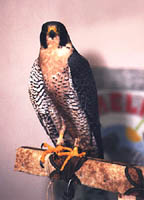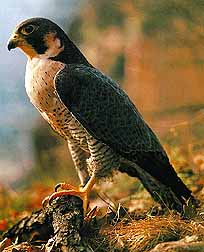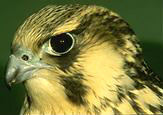Peregrine — Falco Peregrinus
|
|
|
|
|
 |
THE PEREGRINE is a large, compact falcon, measuring 14 to 18 inches (35 to 45 cm) long. The upper wings, crown and side of the head, are blue-gray, while the chest and leg feathers are white, flecked with short black horizontal stripes, increasing toward the feet (moreso on the female). Its hooked beak and outline around its large, dark eyes is yellowish.Its feet are large and possess dagger-like black claws.The birds tend to be darker in the norther regions and paler in the southerly and desert zones.
 The female is called the 'falcon' and the male is the 'tiercel' (from the latin tierce; a reference to the fact that the male is about a third smaller than the female).
The female is called the 'falcon' and the male is the 'tiercel' (from the latin tierce; a reference to the fact that the male is about a third smaller than the female).
 There are eighteen identifiable subspecies of Peregrine throughout the world, inhabiting all continents except Antartica. They are often found near sea cliffs or mountainous country though it can be found cruising open locales for prey. Peregrines from northern regions typically fly south to warmer climes during the winter months.
There are eighteen identifiable subspecies of Peregrine throughout the world, inhabiting all continents except Antartica. They are often found near sea cliffs or mountainous country though it can be found cruising open locales for prey. Peregrines from northern regions typically fly south to warmer climes during the winter months.
 The Peregrine is considered an excellent flyer and a supreme hunter among birds of prey. Since ancient times in the Middle East, falconry and carries great prestige and Peregrines are highly prized by Arab falconers. From the Middle Ages to recent times, the Peregrine has been a favorite choice as a falconer's bird in Britain. It hunts for birds ranging in size from small Passerines to those as large as Geese. Typical prey includes Pigeons, Gulls, Ducks, and even Herons. It will also eat small mammals, reptiles, and insects.
The Peregrine is considered an excellent flyer and a supreme hunter among birds of prey. Since ancient times in the Middle East, falconry and carries great prestige and Peregrines are highly prized by Arab falconers. From the Middle Ages to recent times, the Peregrine has been a favorite choice as a falconer's bird in Britain. It hunts for birds ranging in size from small Passerines to those as large as Geese. Typical prey includes Pigeons, Gulls, Ducks, and even Herons. It will also eat small mammals, reptiles, and insects.
 Attacking with its wings drawn almost to its sides, a Peregrine's deadly accurate dive (or 'stoop') speed has been recorded between 65 to 250 mph (400 km/h).The speed of the strike alone, and the damage inflicted by the Peregrine's hind claw (ripping open the bird's back or removing its head) is often sufficient for the Peregrine to kill its victim. However, if not killed in flight, the prey will invariably die upon impact with the earth upon its release after striking. When retrieved, the prey is partly plucked before being eaten — a pile of feathers is a fair indication that a Peregrine is in the area.
Attacking with its wings drawn almost to its sides, a Peregrine's deadly accurate dive (or 'stoop') speed has been recorded between 65 to 250 mph (400 km/h).The speed of the strike alone, and the damage inflicted by the Peregrine's hind claw (ripping open the bird's back or removing its head) is often sufficient for the Peregrine to kill its victim. However, if not killed in flight, the prey will invariably die upon impact with the earth upon its release after striking. When retrieved, the prey is partly plucked before being eaten — a pile of feathers is a fair indication that a Peregrine is in the area.
Nesting
The Peregrine's nesting site, anaerie or eyrie, is frequently a ledge or hole in a cliff face. The falcons devote little time to building the nest, simply scraping out a shallow basin in stones or soil, or reusing an existing nest of a Raven or Crow. In coastal locales Peregrines nest among steep ocean cliffs where they prey upon nesting seabirds. Some nest sites continue to be used year after year — some for as long as centuries.
 The female will lay one brood of 3 to 4 oval-shaped eggs, creamy-buff in color and usually covered by red-brown markings. In the Northern Hemisphere this usually takes place in mid-April. Both sexes will take turns incubating the eggs for 28 to 32 days when the white-downy chicks eyasses, hatch. Both parents are attentative to their young and will hunt and return with food which is torn up and fed in small strips.The eyasses will leave the nest after six weeks but will remain with their parents until the autumn, after which they will strike out on their own.
The female will lay one brood of 3 to 4 oval-shaped eggs, creamy-buff in color and usually covered by red-brown markings. In the Northern Hemisphere this usually takes place in mid-April. Both sexes will take turns incubating the eggs for 28 to 32 days when the white-downy chicks eyasses, hatch. Both parents are attentative to their young and will hunt and return with food which is torn up and fed in small strips.The eyasses will leave the nest after six weeks but will remain with their parents until the autumn, after which they will strike out on their own.
 |
 |
|
|
An Endangered Species
Prior to World War II the Peregrine was widespread but uncommon in North America and Europe. However, extensive use of DDT, an organochlorine pesticide applied in massive quantities worldwide for agricultural use during the mid-1940's took a terrible toll on the species, exterminating it totally in some areas. The toxin broke down to a more stable form DDE, and made its way into natural ecosystems where it remained potent for decades. Moving up the food chain and eventually ingested by Peregrines, DDE accumulated in concentrated quantities in the fatty tissues causing death, infertility, or disrupting the female's calcium metabolism and producing thin-shelled eggs which easily crushed under the weight of an incubating adult.
 Peregrine populations in the eastern United States, Canada, and Europe were devasted by this chemical. Before the advent of DDT a unique and stable form of the species, the Eastern Peregrine, comprising of about 800 Peregrines, nested across a vast area incorporating the Appalacians from Georgia to Maine and on to Quebec, and as far west as the Mississipi Valley and the Great Lakes. By the mid-1960's however, the birds had been completely exterminated.
Peregrine populations in the eastern United States, Canada, and Europe were devasted by this chemical. Before the advent of DDT a unique and stable form of the species, the Eastern Peregrine, comprising of about 800 Peregrines, nested across a vast area incorporating the Appalacians from Georgia to Maine and on to Quebec, and as far west as the Mississipi Valley and the Great Lakes. By the mid-1960's however, the birds had been completely exterminated.
 West of the Great Plains, though Peregrines survived as a species, their numbers reduced to 10% of what they were prior to the advent of DDT. In the Artic areas of Canada and Alaska — far from the agricultural areas where DDT was employed — the species still died. They were exposed to the toxin when visiting their South American wintering grounds. Only along the Pacific coastline of Canada and Alaska was the species spared from most of the devistation due to the tendency of this localized subspecies, called Peale's Peregrine by taxonomists, to feed on uncontaminated seabirds.
West of the Great Plains, though Peregrines survived as a species, their numbers reduced to 10% of what they were prior to the advent of DDT. In the Artic areas of Canada and Alaska — far from the agricultural areas where DDT was employed — the species still died. They were exposed to the toxin when visiting their South American wintering grounds. Only along the Pacific coastline of Canada and Alaska was the species spared from most of the devistation due to the tendency of this localized subspecies, called Peale's Peregrine by taxonomists, to feed on uncontaminated seabirds.
 By 1965, ornithologists began to conduct conferences to discuss the tragic loss of this bird; it was estimated that by 1970 all Peregrines would be extinct. The general use of DDT was banned by the Canadian government in 1969, and by the United States in 1972. Both nations then drew up recovery plans for the endangered falcon. The US 'Endangered Species Act' of 1973 came too late to save the eastern Peregrine population but it provided protection for falcons still living elsewhere; the American Peregrine and the Artic Peregrine were both classified as endangered.
By 1965, ornithologists began to conduct conferences to discuss the tragic loss of this bird; it was estimated that by 1970 all Peregrines would be extinct. The general use of DDT was banned by the Canadian government in 1969, and by the United States in 1972. Both nations then drew up recovery plans for the endangered falcon. The US 'Endangered Species Act' of 1973 came too late to save the eastern Peregrine population but it provided protection for falcons still living elsewhere; the American Peregrine and the Artic Peregrine were both classified as endangered.
In Canada, peregrines have been on the endangered species list since 1977, at which time there were no known breeding pairs in the province of Ontario.
 Today, with assistance from wildlife resource management teams in Canada and the US, Peregrine populations are begining to see a comeback, though their precarious status is still far from secure. As of the year 2000, there are 23 known breeding pairs of peregrines in Ontario. When the total reaches 40, they will be removed from the endangered list.
Today, with assistance from wildlife resource management teams in Canada and the US, Peregrine populations are begining to see a comeback, though their precarious status is still far from secure. As of the year 2000, there are 23 known breeding pairs of peregrines in Ontario. When the total reaches 40, they will be removed from the endangered list.
To see more photos of Peregrine Falcons CLICK HERE.
Peregrine Nesting Assisted by Mobile Phone Volunteers
For years now, Peregrines have been nesting in urban areas atop high-rise buildings. By the spring of 2000, there were 23 known aeries located in downtown Toronto, Etobicoke, Hamilton, and Ottawa. The Canadian Peregrine Foundation (CPF) installs surveillance cameras so that volunteers can follow the development of the brood which are banded at 21 to 25 days before they take flight at 39 to 42 days. Should any accidents befall a chick, the video feed enables volunteers to provide prompt assistance.
 In February the Canadian Wireless Telecommunications Association (CWTA) staged a gala in Ottawa to honor non-profit groups including the CPF. Since 1996, Clearnet has provided the CPF with over $5000 worth of telecommunications equipment free to each of the Peregrine nesting sites in southern Ontario.
In February the Canadian Wireless Telecommunications Association (CWTA) staged a gala in Ottawa to honor non-profit groups including the CPF. Since 1996, Clearnet has provided the CPF with over $5000 worth of telecommunications equipment free to each of the Peregrine nesting sites in southern Ontario.
Peregrines in Toronto, Spring 1996
High atop an office tower at 18 King St. East, in the downtown core of Toronto a family of Peregrines decided to make their nest last spring. For weeks, pedestrians were able to observe the progress of the eyasses on a huge street-level closed-circuit TV monitor that the building management had installed. Although the birds left in the fall, there is a fair chance that they'll be back to nest next year.
1996 Canadian Platinum Proof Peregrine Coin Set
For 1996 the Canadian Mint released a series of four platinum coins for collectors with unique portraits of Peregrine falcons on its reverse side. The images were created by Saskatchewan artist Dwayne Harty and display a mother and eyasses, a falcon at rest on a branch, a falcon swooping on its prey, and the majestic profile of the falcon's head. The coins are struck in 99.95% pure platinum and are minted in denominations of $300, $150, $75, $30; naturally their metal value makes them worth far more than their face value. They weigh one ounce, one-half ounce, one-quarter ounce, and one-tenth ounce, respectively. Only 1,500 sets are available through coin dealers or the Royal Canadian Mint directly at 1-800-267-1871. Prices range from $159.95 for the $30 coin to $2,095.95 for the four piece set.
Want to Trade Links?
We're always interested in trading links with other gaming and genre websites!
This page was last updated April 24, 2003. Content copyright ©1995 to 2023 Kevin Davies.






![]() In February the Canadian Wireless Telecommunications Association (CWTA) staged a gala in Ottawa to honor non-profit groups including the CPF. Since 1996, Clearnet has provided the CPF with over $5000 worth of telecommunications equipment free to each of the Peregrine nesting sites in southern Ontario.
In February the Canadian Wireless Telecommunications Association (CWTA) staged a gala in Ottawa to honor non-profit groups including the CPF. Since 1996, Clearnet has provided the CPF with over $5000 worth of telecommunications equipment free to each of the Peregrine nesting sites in southern Ontario.